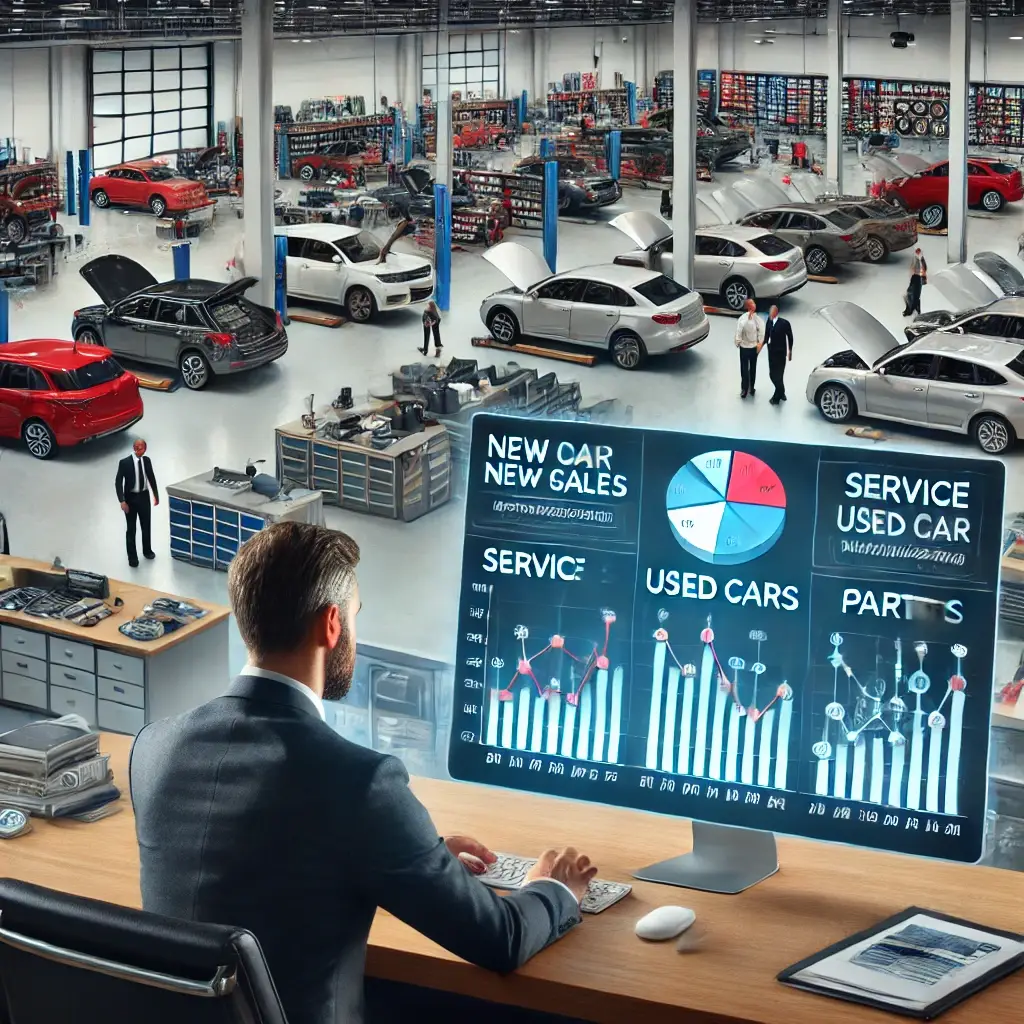A Strategic Approach to Dealership Profitability
For a General Manager, one of the most critical aspects of running a profitable dealership is understanding and optimizing your absorption model. The absorption model is the key to determining how your dealership covers its operating expenses and ultimately drives net profit. While many discussions revolve around fixed operations covering these expenses, it’s important to recognize that each dealership’s absorption model can vary—whether it’s new car sales, used car sales, fixed operations, or a combination of all.
What is the Absorption Model?
The absorption model is essentially a strategic framework that shows how much of your dealership’s operating expenses are covered by different revenue streams. While the traditional absorption business model focuses on fixed operations (service, parts, and body shop) covering all operating costs, many dealerships rely on a mix of new car sales, used car sales, and fixed operations to meet this goal. The model is unique to each dealership based on factors like market conditions, business strategy, and departmental performance.
The formula for determining absorption is simple:
- Absorption Rate = (Gross Profit from All Revenue Streams ÷ Total Dealership Operating Expenses) x 100
A higher absorption rate means your dealership covers more of its expenses through gross profit, leaving additional revenue—like vehicle sales—as pure profit. Understanding how your dealership covers these costs is crucial for long-term success.
Types of Absorption Models:
Different dealerships approach absorption in various ways. The key is to understand which revenue streams are responsible for covering the majority of your expenses and how you can optimize them.
New Car Sales-Focused Absorption Model In some dealerships, new car sales are the primary source of covering operating expenses. This model relies heavily on high sales volume and competitive pricing to drive profitability. However, new car sales can be unpredictable due to market fluctuations, manufacturer incentives, and consumer trends. Therefore, relying on this model alone can make your dealership vulnerable during downturns in the automotive market.
- Benefits: High sales volumes, quick turnaround.
- Challenges: Market volatility, dependence on manufacturer incentives.
Used Car Sales-Focused Absorption Model In a used car-focused absorption model, gross profit from pre-owned vehicle sales plays a significant role in covering expenses. Since used cars typically offer higher gross margins than new cars, this model can provide a more stable revenue stream. However, it requires a strong inventory management system and a team capable of reconditioning and selling used vehicles quickly.
- Benefits: Higher gross margins, less dependency on manufacturers.
- Challenges: Managing inventory quality and reconditioning costs.
Fixed Operations-Focused Absorption Model In this more traditional model, your service, parts, and body shop departments generate enough gross profit to cover your dealership’s expenses. The fixed operations model is attractive because service and parts revenue tend to be consistent, even when car sales slow down. However, you’ll need to focus on driving more repair orders (ROs), increasing customer retention, and upselling parts and accessories to maximize profitability.
- Benefits: Stable revenue from service and parts, less market fluctuation.
- Challenges: Requires high customer retention and upsell efficiency.
Combination Absorption Model For many dealerships, the ideal absorption model is a combination of all revenue streams—new cars, used cars, and fixed operations—working together to cover operating expenses. This diversified approach spreads risk across different departments, ensuring that your dealership remains profitable even if one department underperforms.
- Benefits: Diversified risk, stable profit from multiple sources.
- Challenges: Requires strong collaboration between departments and consistent performance across the dealership.
Understanding and Optimizing Your Absorption Model
Regardless of which absorption model your dealership follows, the goal is the same: to ensure that your expenses are covered and that vehicle sales contribute directly to net profit. Here’s how to understand and optimize your dealership’s absorption model for maximum profitability:
- Assess Departmental Contributions The first step is to assess how much each department—new cars, used cars, and fixed operations—contributes to covering your operating expenses. This will help you understand whether your current model is weighted heavily toward one area or if you’re successfully balancing revenue streams. Tools like the Dealerbible GM Tool can help you track real-time gross profit by department, giving you a clear view of how each area contributes to your overall financial health.
- Set Gross Profit Targets Each department should have clear gross profit targets that align with your dealership’s overall strategy. If your dealership relies heavily on new car sales, for example, you may need to set aggressive sales volume targets to meet your expenses. Conversely, if fixed operations play a significant role, you’ll need to focus on increasing service efficiency and parts sales.
- Monitor Expenses Closely Managing expenses is just as important as increasing revenue when it comes to mastering your absorption model. Conduct regular reviews of operating expenses and look for areas where costs can be reduced without sacrificing performance. The Dealerbible GM Tool offers detailed expense analysis and trending reports, helping you keep expenses in check.
- Diversify Revenue Streams If your dealership is too reliant on one department to cover expenses, it may be time to diversify. For example, if your absorption model is heavily dependent on new car sales, consider investing more in fixed operations to create a more stable revenue stream. Diversification reduces risk and ensures that your dealership can weather market fluctuations.
- Real-Time Financial Monitoring Optimizing your absorption model requires constant vigilance. Use real-time financial tracking tools to monitor your dealership’s performance against set targets. With real-time insights, you can make proactive adjustments to ensure that your dealership stays on track for success.
The Path to Sustainable Profitability
Mastering your dealership’s absorption model is a dynamic process that requires a deep understanding of how each department contributes to covering operating expenses. Whether your model relies on new car sales, used car sales, fixed operations, or a combination of all three, the key is to balance and optimize these revenue streams to drive sustainable profitability.
Ready to take control of your dealership’s absorption model? The Dealerbible GM Tool provides the insights and features you need to strategically plan, monitor, and optimize your dealership’s financial performance. By understanding your absorption model and making data-driven decisions, you can ensure long-term success and profitability for your dealership.







